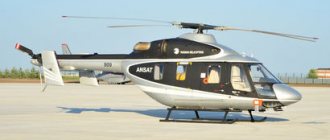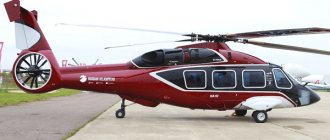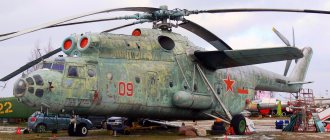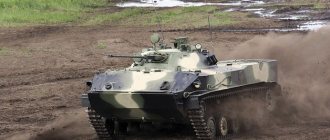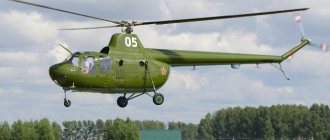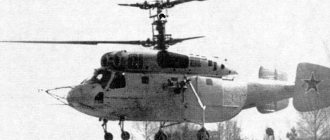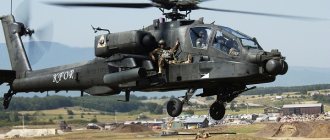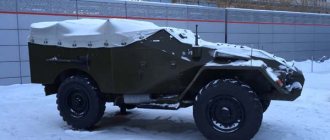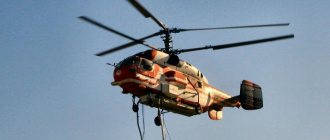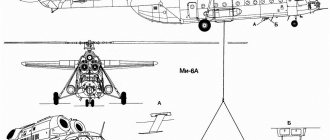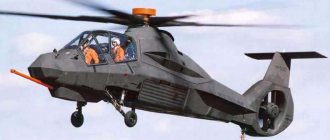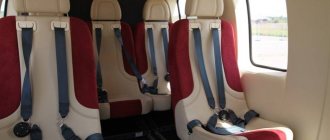History of creation
Not only civil aviation, but also the military needed a new helicopter, therefore, on May 30, 1960. A decree of the USSR Government was issued, according to which the Mil Design Bureau was entrusted with the creation of a light helicopter. The vehicle was immediately designed as a multi-purpose vehicle, in passenger, agricultural, transport, sanitary and training modifications. The project received the designation B-2. When creating a new aircraft, the designers tried to use components and assemblies from the Mi-1 as much as possible. But the result was a completely new car. In January 1961 The State Commission signed an Act on the B-2 model, and in August of the same year, the first prototype was built at the experimental plant of the Mil Design Bureau. A month later, factory tests began, and on September 22, 1961. the experimental machine took off from the ground. After a short hover, test pilot G.V. Alferov, made a 15-minute flight at low speed. The second prototype B-2 was tested in December of the same year by test pilot B.A. Anopov, after which, at the beginning of 1962, he was sent to State tests. Despite their successful completion, a number of shortcomings were identified that had to be eliminated. The complaints, in particular, concerned the power plant, GTD-350 engines and agricultural equipment. In September 1962, after demonstrating the new machine to members of the Soviet government and representatives of the Polish People's Republic, it was decided to organize mass production of the helicopter, under the designation Mi-2, in Poland . In 1964 an agreement was concluded under which a license for the construction of helicopters and engines for them was transferred to Poland, the Soviet Union also guaranteed the purchase from the Poles of a sufficient number of machines, engines and spare parts for them. Soviet engineers went to factories in Szczwidnik and Rzeszow to help Polish specialists master new production technologies. The first production Mi-2, assembled from Soviet parts, took off on August 26, 1965, and in November of the same year, a helicopter completely built in Poland made its first flight. The very next year, serial production of Mi-2 helicopters reached full capacity. Mi-2 helicopters are still in operation today, they are used for both civil and military purposes. In the national economy, the Mi-2 could be used for spraying and pollinating fields and forests, and for cargo and passenger transportation. In Arctic conditions, for ice reconnaissance, and traffic police units used these vehicles to monitor road conditions from the air. The Mi-2 has set many world records in various helicopter sports disciplines. In the army, the Mi-2 could be used as a communications, transport, fire support helicopter, for training cadets in flight schools and DOSAAF schools. He took part in several local conflicts. This helicopter was also used during the liquidation of the consequences of the Chernobyl accident. The Mi-2 was produced serially until 1992. During this time, 5,400 vehicles were built. Since 1965 it was supplied to the USSR and other countries of the socialist camp.
Description
The Mi-4 helicopter is designed with one main rotor and one tail rotor. It is equipped with a single piston engine and a four-wheel chassis. The Mi-4 crew consists of three people.
The fuselage of the Mi-4 is semi-monocoque, the piston engine is installed in the nose of the vehicle. The central part of the helicopter fuselage is occupied by the cargo compartment; it has a volume of 16 cubic meters and a hatch with a cargo ramp located in the rear. Its doors open to the sides. On the left side of the body there is a door into which you can install an electric winch for hanging cargo.
The cargo compartment has folding seats for paratroopers; the helicopter can take twelve people on board. The cockpit is located above the cargo compartment. For the most part it consists of glass panels and has good visibility.
Immediately behind the cockpit is the fuel tank and main gearbox. An additional tank can be installed inside the cargo compartment, which significantly increases the vehicle's flight range. The main fuel tank has a capacity of 1 thousand liters.
The tail boom has a conical shape and an oval cross-section, the end boom is deflected upward.
The main rotor of the Mi-4 helicopter is four-blade; it consists of steel spars and a wooden frame. Its diameter is 21 meters. On later modifications of the helicopter, the main rotor blades were made of aluminum alloy (spar) and glued sections of honeycomb filler. The new blade design has a service life of up to 2.5 thousand hours.
The tail rotor has three blades and is made of wood. Most of the helicopter's moving parts and the flight deck are equipped with anti-icing systems.
The Mi-4 has a four-wheel chassis. The main supports have a truss structure and are equipped with oil-air shock absorbers, the wheels on the front supports are self-orienting, and a safety support is installed at the bottom end of the tail boom.
The Mi-4 power plant consists of a double-row air-cooled ASh-82V piston engine located in the nose of the helicopter.
The navigation and flight equipment of the vehicle consists of a radio compass, a radio station, an RV-2 radio altimeter, a radar, and an SPU-2 intercom. It allows you to control a helicopter in difficult weather conditions and at any time of the day. The Mi-4 was equipped with oxygen equipment, which allowed the crew to perform high-altitude flights.
Military modifications of the vehicle had a 12.7 mm machine gun installed under the fuselage. A special gondola was provided for the shooter. The helicopter could be equipped with Phalanx ATGMs, unguided rockets or four bombs of 250 kg each.
Specifications:
Fuselage length: 11.4 m. Fuselage width: 3.25 m. Length with rotation. propellers 17.42 m. Height 3.75 m. Main rotor diameter 14.50 m. Tail rotor diameter 2.7 m. Engine type: 2 GTD Klimov GTD-350 Engine power: 2 x 405 hp. Empty weight: 2400 kg. Normal take-off weight: 3700 kg. Maximum take-off weight: 3700 kg. Maximum speed: 210 km/h Cruising speed: 190 km/h Maximum flight range: 580 km Rate of climb: 270 m/min Service ceiling: 4000 m Crew: 1 person Payload: 10 passengers or 4 stretchers with one attendant or 700 kg cargo in the cabin or 800 kg of cargo on an external sling (hook).
Photos of the Mi-2 Helicopter USSR-23855 (541308119) were taken at the Ulyanovsk Museum of Civil Aviation on August 4, 2013. There is also a video review of this aircraft in HD quality.
As for the Mi-2 models, it is produced in 1:48 scale by AeroPlast, and in 1:72 scale, a rather good line, of various modifications, is produced by the Chinese company Hobby Boss. But we will talk about the models of this car in another article.
The most famous disasters
The history of the helicopter's operation includes two serious crashes of the Mi-6. The first of them occurred in Novoagansk on January 3, 1984. At that time, the vehicle was used to transport passengers and cargo as part of an oil field exploration expedition. She failed to gain the required altitude, as a result of which the helicopter hit the ground and, turning over to the left side, burned out. The tragedy led to the death of 38 passengers. As the results of the investigation into this incident showed, the cause of the incident was the excessive weight of the helicopter.
On December 11, 1990, another Mi-6 crashed near the Belarusian town of Korbin. The helicopter landed in very difficult weather conditions. The crew failed to control the aircraft, which resulted in the aircraft reaching a critical pitch angle. As a result, the car crashed to the ground and caught fire. All four crew members then died from their injuries.
Videos and photos walkaround
Part 1
Part 2
Description
The Mi-1 helicopter is designed according to the classical design with one main rotor and a tail rotor on the end boom. The fuselage of the vehicle is a semi-monocoque type, with an end beam deflected upward and controlled by a stabilizer. The fuselage skin is made of aluminum alloy. The helicopter landing gear is non-retractable, tricycle.
In front of the fuselage there was a glass cockpit for the pilot and passengers. Seats for two passengers were located immediately behind the pilot's seat. At the rear of the fuselage there was an engine compartment with a motor, main gearbox, main rotor brake and axial fan.
The Mi-1 main rotor is three-bladed, the blades are hinged, and the propeller is equipped with friction dampers. The blades are trapezoidal in shape; they have a mixed design - steel spars and wooden ribs, covered with plywood and canvas on top. The latest modifications of the Mi-1 had all-metal blades. The tail rotor also has three trapezoidal blades; they were made of wood.
The main landing gear of the helicopter has a truss structure, and the front wheel is self-orienting. There is a tail foot on the end boom to prevent the tail rotor from touching the ground. The Mi-1 helicopter was equipped with a parking brake.
The Mi-1 power plant consisted of a star-shaped AI-26V piston engine, which was installed horizontally and rotated the main rotor through a gearbox, and the tail rotor through a system of shafts and gearboxes. The engine was started using compressed air, the supply of which was relatively small. To be able to take off in remote areas (taiga, mountains), pilots often carried an additional cylinder with them.
The helicopter had a fuel tank with a capacity of 240 liters. On the Mi-1 it was possible to install an additional tank for 160 liters of fuel.
Operators
Current
- Uzbekistan - 26 Mi-6 units and 2 Mi-22 units (Mi-6AYA), as of 2020[5]
- Laos - one Mi-6 unit as of 2020[6]
Former military
- USSR
- Algeria - 4 - 5 Mi-6T units delivered from the USSR in 1972[7]
- Belarus - several Mi-6 units as of 2013
- Vietnam - 10 Mi-6T units delivered from the USSR in 1966 and 1970[7]
- Egypt - 19 Mi-6T units were supplied from the USSR in 1965 and 1971[7]
- Indonesia - 8 Mi-6T units delivered from the USSR in 1965[7]
- Iraq - from 10 to 13 Mi-6T units delivered from the USSR in 1973[7]
- Pakistan - 1 Mi-6T unit delivered from the USSR in 1968[7]
- Peru - from 6 to 16 Mi-6T units were delivered from the USSR in the period from 1971 to 1972[7]
- Poland - 3 Mi-6s were in service with the Polish Armed Forces in 1986-1990; 2 helicopters were sold to Ukraine and 1 was transferred to the aviation museum[8]
- Russia - 10 Mi-6 units as of 2013[9]
- Syria - 10 Mi-6T units were supplied from the USSR between 1972 and 1973[7]
- Ethiopia - from 4 to 10 Mi-6T units delivered from the USSR in 1978[7]
Civil
- USSR
- Poland - 3 Mi-6A were operated in 1974-1985 [ source not specified 2175 days
]
Modifications
| Model name | Brief characteristics, differences |
| Mi-6A | A new basic modification of the helicopter, created in 1971 as a result of numerous modifications |
| Mi-6ATZ | Tanker based on the Mi-6A transport helicopter |
| Mi-6VKP | Air command post. |
| Mi-6M | Basic anti-submarine helicopter, work on which began in 1958. |
| Mi-6P | Passenger modification of the helicopter (Salon), created in 1965. |
| Mi-6PZh | Fire option. |
| Mi-6PP | Jammer for radio reconnaissance and detection systems of the AWACS type. Not mass-produced. |
| Mi-6PRTBV | Helicopter-type mobile missile and technical base. |
| Mi-6PS | Search and rescue helicopter. |
| Mi-6RVK | Rocket and helicopter complex. |
| Mi-6TZ | Fuel tanker for ground forces and aviation. |
| Mi-22 (Mi-6AYA) | Air command post. |
Production
Serial production of the Mi-6 was launched simultaneously at two enterprises: Moscow plant No. 23 and Rostov plant No. 168[1].
In 1959, the first 4 serial Mi-6s were produced at the Rostov plant No. 168. The production of the Mi-6 in Rostov continued until 1980, when it was replaced by the more advanced Mi-26. From 1959 to 1980, the company produced 874 Mi-6s[1].
Only 50 Mi-6s were produced in Moscow between 1960 and 1962, due to the plant’s transition to producing rocket and space technology.
Mi-6 design
The helicopter is designed according to a single-rotor design with a wing and a tail rotor. The pilot's cabin is located in the bow. The cargo-passenger cabin is located under the fuel and engine compartments. Thanks to the reinforced floor with mooring points, it became possible to transport heavy loads, including military equipment. The external suspension can be dismantled, this is used for transporting large cargo weighing up to 8 tons.
The auxiliary hydraulic system controls the doors, windshield wipers and ladders. The propeller blades are made from a solid metal tube. To avoid icing, the tail rotor blades are equipped with an alcohol anti-icing system, and the main rotor blades are equipped with an electrothermal one. The Mi-6 is equipped with a non-retractable tricycle landing gear, the front wheels are dual and self-orienting.
